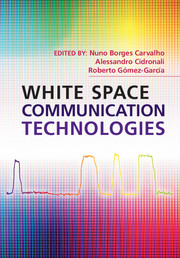Book contents
- Frontmatter
- Contents
- List of contributors
- Preface
- List of abbreviations
- Part I White space technology signal processing and digital design
- Part II Adaptable receivers for white space technologies
- Part III Adaptable transceivers for white space technologies
- 7 White spaces exploration using FPGA-based all-digital transmitters
- 8 Interference active cancelation techniques for agile transceivers
- 9 Highly efficient transmitter architectures
- Index
9 - Highly efficient transmitter architectures
from Part III - Adaptable transceivers for white space technologies
Published online by Cambridge University Press: 05 October 2014
- Frontmatter
- Contents
- List of contributors
- Preface
- List of abbreviations
- Part I White space technology signal processing and digital design
- Part II Adaptable receivers for white space technologies
- Part III Adaptable transceivers for white space technologies
- 7 White spaces exploration using FPGA-based all-digital transmitters
- 8 Interference active cancelation techniques for agile transceivers
- 9 Highly efficient transmitter architectures
- Index
Summary
Introduction
Since its inception in 1999, cognitive radio (CR) has been considered a promising means to use white space channels and thereby make more efficient usage of spectrum. To become the enabling technology for secondary access to TV white spaces (TVWS) requires facing several challenges in radio transceiver devices due to the continuous changes in both bandwidth and transmission frequency. As a consequence, CR requires configurable radio platforms. The development of software-defined radio (SDR) technology has made modern wireless transceivers more versatile, powerful, and portable by performing baseband processing.
As already mentioned in Chapter 1, the United States Federal Communications Commission (FCC) allowed in November 2008 the unlicensed use of the spectrum designated for TV broadcast [1]. Two categories of device use were defined: fixed devices and personal portable devices. Focusing on the mobile (personal portable) devices, the available spectrum is on channels 21–51 (except 37 reserved for wireless microphones) corresponding to the UHF frequency band comprised of between 512 and 698 MHz. Therefore, excluding channel 37, and also 36 and 38 reserved as guard channels, there is the potential for up to 168 MHz of available spectrum whose availability is determined by the presence (or lack thereof) of primary users.
- Type
- Chapter
- Information
- White Space Communication Technologies , pp. 262 - 279Publisher: Cambridge University PressPrint publication year: 2014



